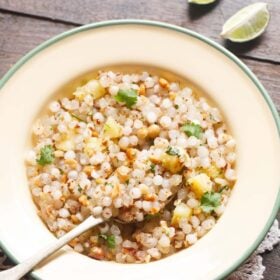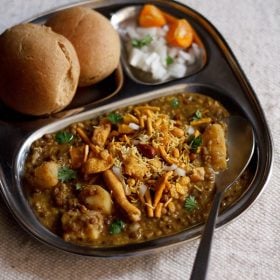Misal pav is a popular Maharashtrian street food of usal (sprouts curry) topped with onions, tomatoes, farsan (fried savory mixture), lemon juice, coriander leaves and served with a side of soft pav (Indian dinner rolls). The sprouts curry is made from moth bean sprouts. This misal recipe is a tasty and filling vegan dish that can be served as breakfast, lunch or brunch.
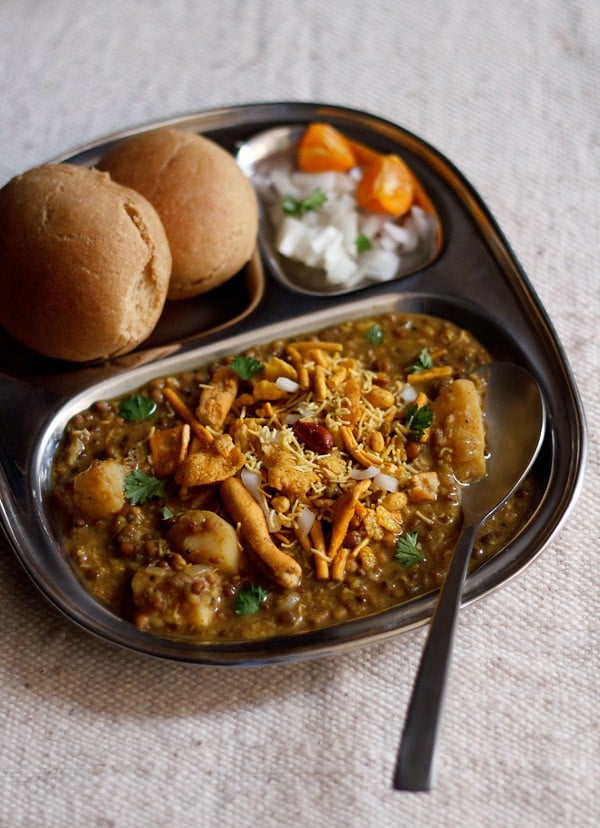
About Misal Pav
The word “Misal” here is for the sprouts curry and Pav are Indian dinner rolls. Actually, in the Marathi language, the word misal means mixture. This sprouts curry is also called as usal.
There are many variations of making misal pav in Maharashtra. Usually, moth bean sprouts (also known as matki in Marathi language) is used to make the misal. But if you don’t have sprouted moth beans then make the misal recipe with mixed beans sprouts or sprouted moong beans.
Growing up in Mumbai, I have had misal pav in many places. My mom would also make misal pav at home many times. This is one of my favorite Maharashtrian breakfast recipe.
I usually make the misal less spicy as that is how we prefer it. But there are some really spicy misal like the Kolhapuri misal where the Kolhapuri masala is added. There is also a much milder version of Puneri misal from the city of Pune.
I either make this misal curry with matki sprouts or my mom’s Usal Recipe for making misal pav. I also add potatoes in my misal recipe to make it a hearty dish. But feel free to skip them if you are not fond of potatoes or do not have them.
Many times I simply make the sprouts curry and serve it with some roti or steamed rice. Yes this curry also tastes good with rice or roti. If you do not have pav, then enjoy it with bread.
I usually use less oil, so you won’t see a thin layer of oil on the curry as is seen in most misal recipes. But feel free to add more oil if you prefer.
In this recipe I have used homemade moth bean sprouts. If you want to know how to sprouts moth beans or mung beans, then you can check the method here on How to sprout Mung Beans.
Below you can see the photo of sprouted moth beans. They have a wonderful nutty taste that adds a lot of flavor to the curry. Like most beans or legumes these moth beans are also very healthy.

Misal pav can be had as a breakfast, snack or as brunch. It’s a delicious and wholesome meal, especially if the pav (buns) is made from wheat flour or if you could make your own healthy bread.
I usually make Wheat pav or buns at home whenever I make misal pav. I have also shared the recipe of Ladi pav.
How to make Misal Pav
Cooking Moth Bean Sprouts
1. Rinse 2 cups of moth bean sprouts first in running water a couple of times.
If you don’t have moth bean sprouts use moong bean sprouts or mixed beans sprouts. Ensure that your sprouts are clean, fresh and do not have fungus or mould on them or a stinky smell.
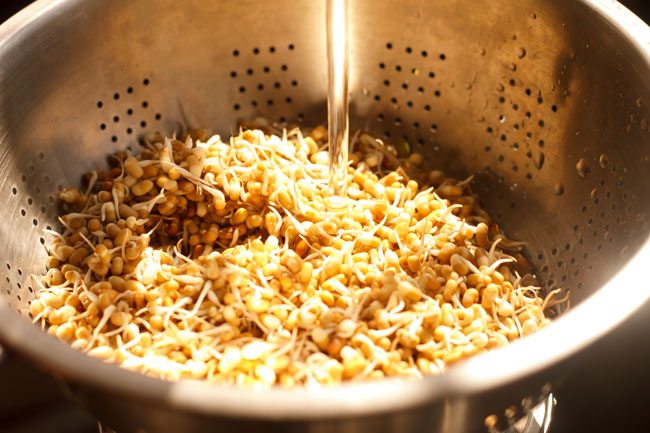
2. Drain the water from the sprouts very well and add the sprouts to a 3 litre stove-top pressure cooker.
You can also cook them in a pot or Instant pot adding enough water as required.

3. Also add 2 medium-sized potatoes (chopped) and ¼ teaspoon turmeric powder as required in the pressure cooker.
Note that including potatoes are optional and can be skipped.

4. Add 3 cups water or as required. Note that the water should be covering the matki sprouts and potatoes about 2 inches above. The quantity of water will vary with the depth and length of the pressure cooker, so add more water if needed.
Keep in mind that if using mixed bean sprouts, then you will have to add more water, but for mung bean sprouts, add 3 cups water.
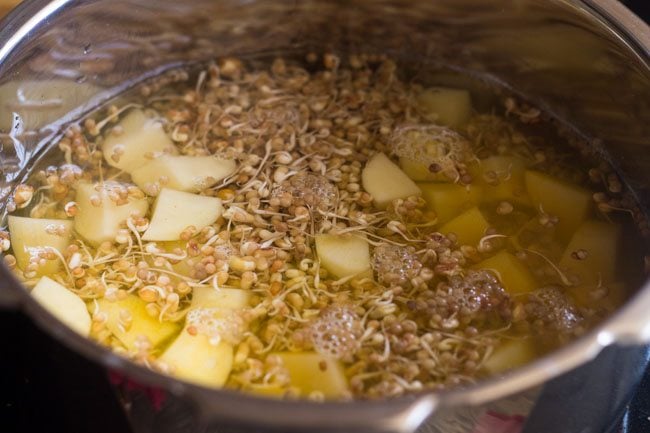
5. Add ½ teaspoon of salt or as required.

6. Pressure cook for 2 to 3 whistles on medium heat. When the pressure falls or reduces on its own then only open the lid of the pressure cooker.
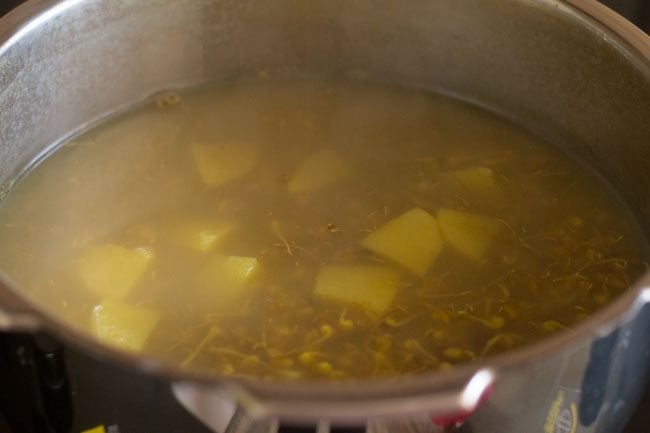
More Prep
7. In a small bowl, soak the tamarind in ⅓ or ½ cup warm or hot water for 25 to 30 minutes.
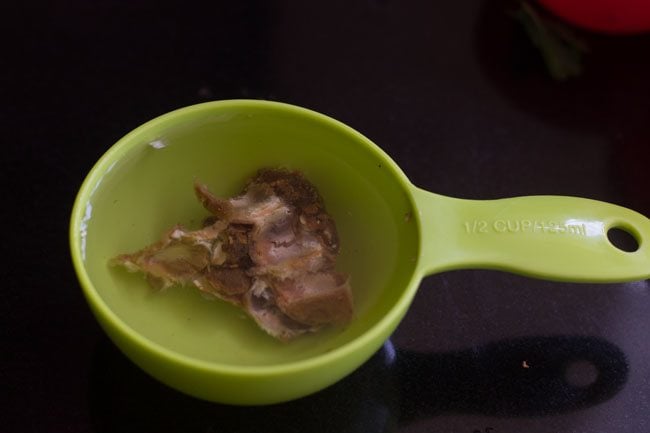
8. Squeeze the tamarind and extract the pulp. Keep the tamarind pulp aside. We will be using it later.
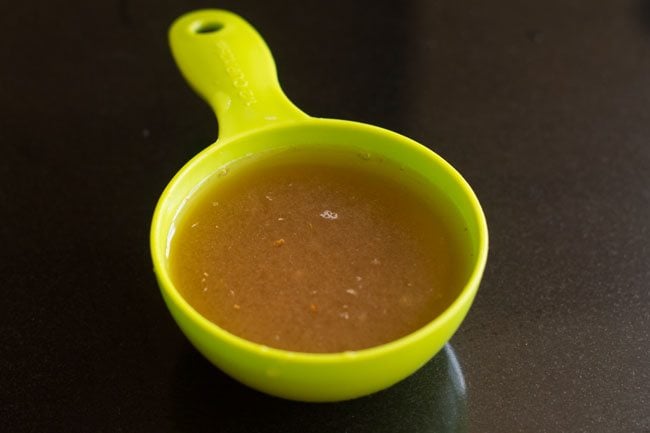
9. Measure and keep all the spices ready.
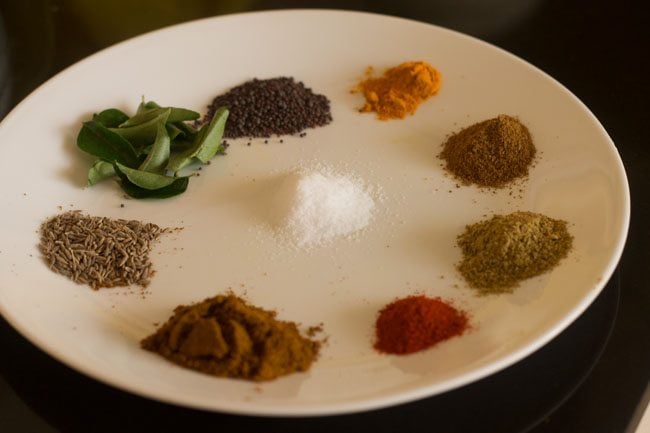
Making Misal (Usal)
10. Heat 3 tablespoons of oil in another pan. Crackle 1 teaspoon of mustard seeds first at low to medium-low heat.
You can use any neutral-flavored oil or peanut oil.
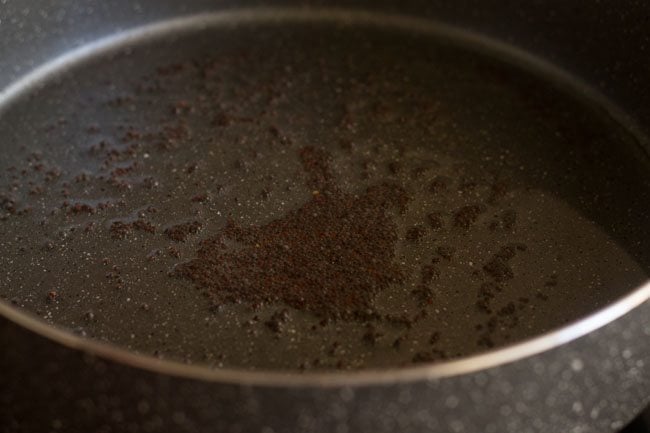
12. Then add 1 teaspoon of cumin seeds. Saute for some seconds till the cumin gets golden.

13. Add one large or medium-sized onion (chopped).

14. Saute stirring often till the onions soften and turn translucent.
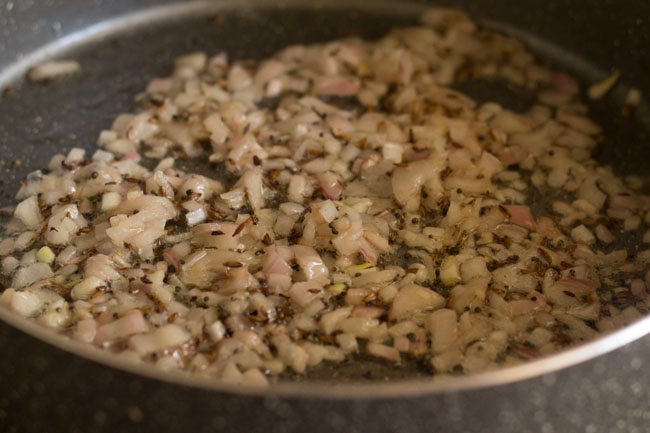
15. Then add the following ingredients:
- 10 to 12 curry leaves
- 1 to 1.5 teaspoon ginger-garlic paste (or 3 to 4 garlic cloves + 1 inch ginger, crushed to a paste in mortar-pestle)
- 1 to 2 green chilies (chopped)

16. Stir and saute for some seconds or till the raw aroma of ginger-garlic goes away.
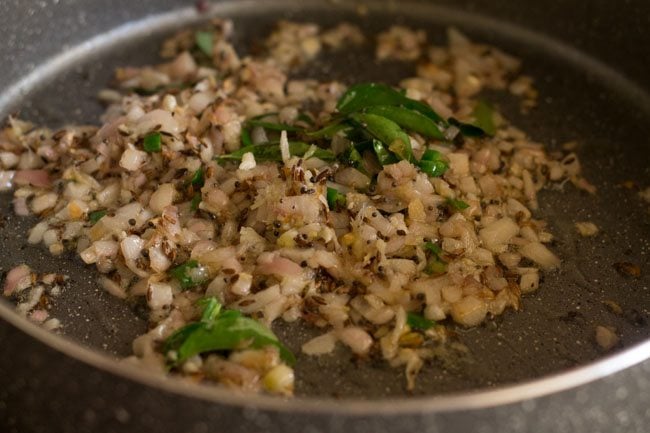
17. Add the remaining ground spices listed below:
- ¼ teaspoon turmeric powder
- 1 teaspoon coriander powder
- 1 teaspoon cumin powder
- ½ teaspoon red chili powder or cayenne pepper
- 1 to 1.5 tablespoons of goda masala (though not authentic but can swap with ½ to 1 teaspoon garam masala instead)
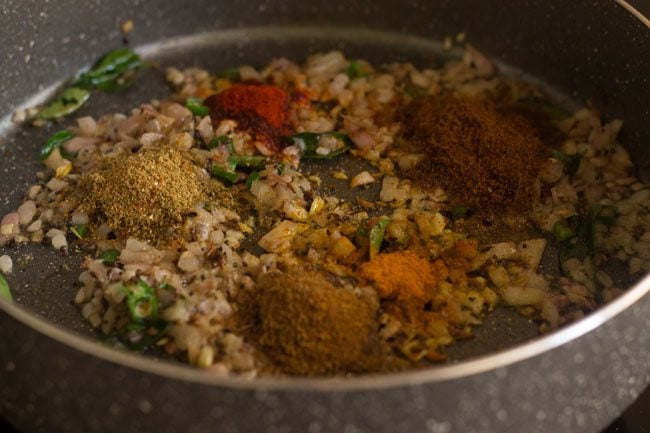
18. Stir with a spoon and mix the spice powders well. Keep the heat to a low so that the spices don’t get burnt.
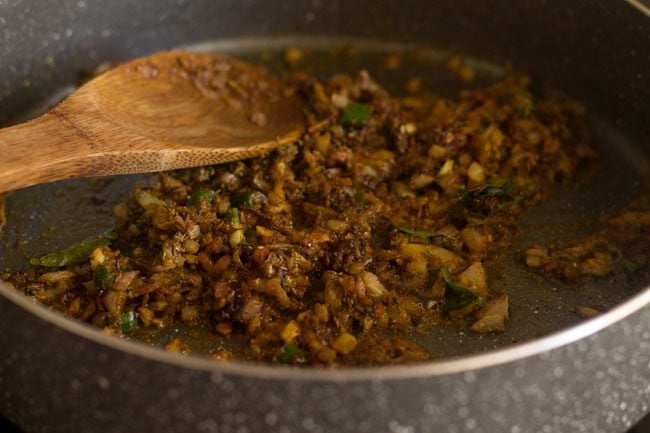
19. Then add the prepared tamarind pulp.
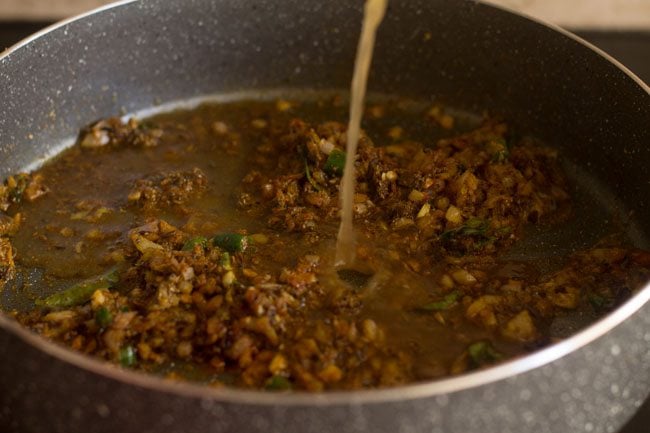
20. Simmer on low or medium-low heat till the raw aroma of the tamarind goes away.

21. Drain the water from the pressure-cooked matki sprouts and potatoes with a colander.
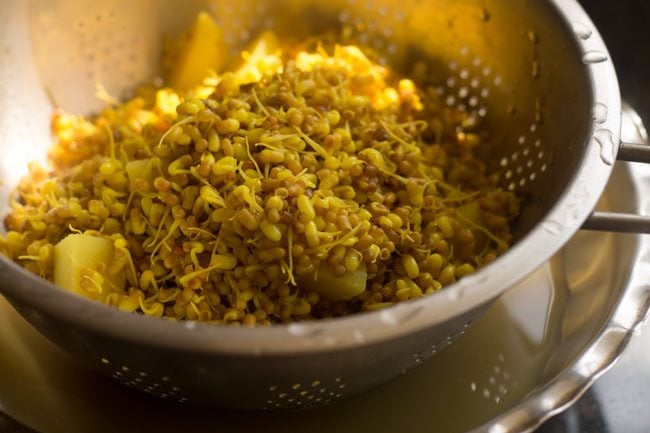
22. Add the cooked sprouts and potatoes to the pan.

23. Stir and add ¾ to 1 cup water or more water if required. Usually the misal curry is medium or thin in consistency. So adjust water according to the consistency you prefer, but do not make it very thin as this will dilute the flavors.
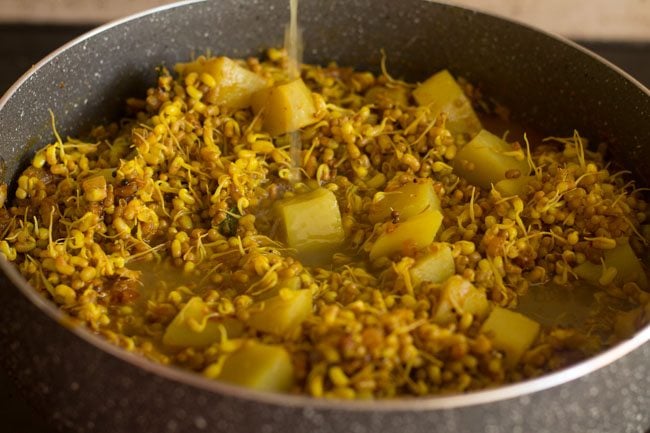
24. Season with salt as required.
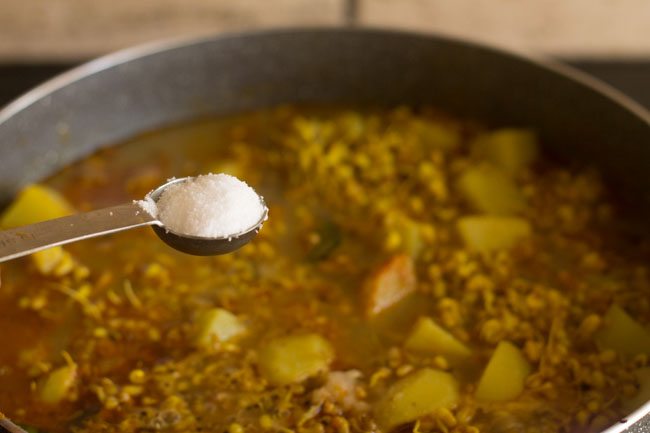
25. If you want you can also add 1 teaspoon of sugar or jaggery for a slight sweet taste.

26. Simmer the usal for 8 to 10 minutes on low heat with occasional stirrings. You can adjust the consistency by adding more or less water. On simmering, the usal consistency will thicken so keep this in mind while adding water.

27. Lastly garnish with coriander leaves.

Assembling Misal Pav
28. Whilst the misal is simmering, you can prep the toppings for the misal pav. Finely chop the onion and tomato. Keep aside. Tomatoes are optional and can be skipped if you want.

29. Take the steaming hot usal in 4 to 5 serving bowls or shallow plates.
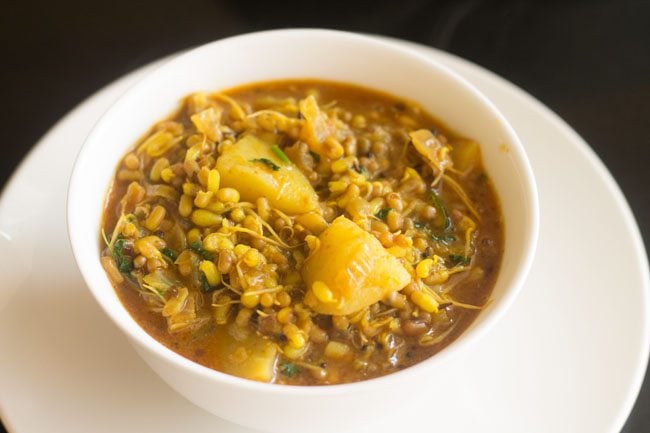
30. In each bowl of usal, first add some of the chopped onions and tomatoes.
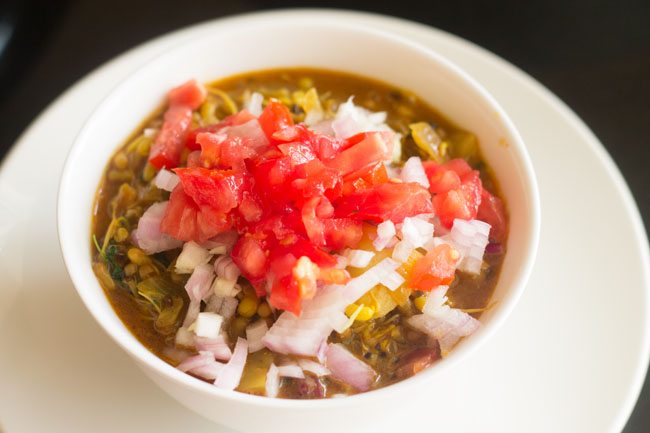
31. Then top the usal with chopped coriander leaves.
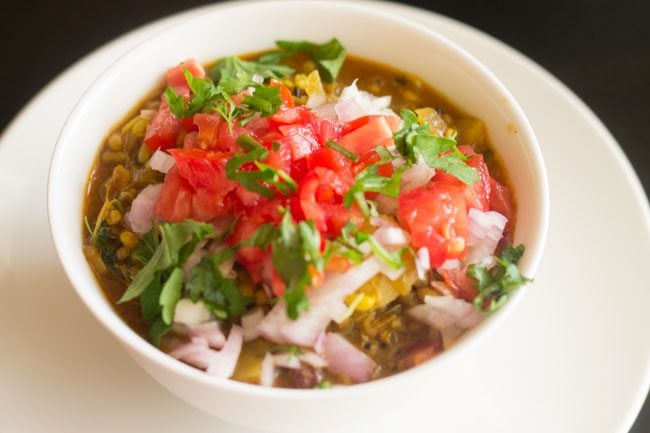
32. Squeeze a few drops of lemon juice for some tang. Then top it with farsan or chiwda as per your preference.

33. Serve a side of some lemon wedges, chopped onions and mix farsan/sev/chiwda. Serve the Misal in a bowl or a plate with pav buns. You can also serve misal with a side of buttermilk (chass) or curd (yogurt) as it balances the spiciness of the usal.
Enjoy the misal pav hot as soon as it is assembled. Otherwise the farsan topping becomes soggy.
So to get the best flavor and texture assemble the misal pav when you want to eat it. Misal pav makes for a filling breakfast, brunch or lunch.

More street food recipes
Please be sure to rate the recipe in the recipe card or leave a comment below if you have made it. For more vegetarian inspirations, Sign Up for my emails or follow me on Instagram, Youtube, Facebook, Pinterest or Twitter.

Misal Pav (Misal Recipe)
Ingredients
For cooking sprouts
- 2 cups moth bean sprouts (matki sprouts) or mixed bean sprouts or moong bean sprouts – I used about 1 cup of moth beans to prepare the sprouts
- 2 potatoes small to medium – cubed in 1.5 to 2 inches
- ½ teaspoon turmeric powder
- ½ teaspoon salt
- 3 cups water or as required
For the usal (sprouts curry)
- 1 onion medium to large – finely chopped
- 1 to 2 green chilies – chopped
- 1 to 1.5 teaspoon Ginger Garlic Paste or 3 to 4 garlic cloves + 1 inch ginger- crushed in a mortar-pestle to a fine paste
- 1 teaspoon mustard seeds
- 1 teaspoon cumin seeds
- 10 to 12 curry leaves
- 1 to 1.5 tablespoon Goda Masala or kala masala
- ½ teaspoon red chili powder
- ¼ teaspoon turmeric powder
- 1 teaspoon Coriander Powder
- 1 teaspoon cumin powder
- 1.5 teaspoons tamarind – soaked in ⅓ or ½ cup water or 2 to 3 kokums
- ¾ to 1 cup water or add as required
- 3 tablespoons oil
- salt as required
For the misal pav
- 8 to 10 pav (bread rolls) or bread slices as required
- ½ cup finely chopped onions
- ½ cup finely chopped tomatoes optional
- ½ to 1 cup thick sev or farsan (chiwda), fried savory snack mixture
- 1 lemon or lime quartered or diced
- ⅓ cup chopped coriander leaves
- ½ cup Curd or yogurt, beaten, optional
Instructions
Preparation
- Rinse the moth bean sprouts first in running water a couple of times.
- Drain the water and then add the sprouts, cubed potatoes turmeric powder and salt in a pressure cooker.
- Add water and mix well. If using mixed bean sprouts, you will have to add more water. Note that the water should be covering the matki sprouts about 2 inches above. The quantity of water will vary with the depth and length of the pressure cooker, so add more water if needed.
- Pressure cook for 2 to 3 whistles. You can also cook the bean sprouts in a pan or Instant pot adding required amount of water.
- In a small bowl soak the tamarind in ⅓ or ½ cup warm water for 25 to 30 minutes.
- Squeeze the tamarind and extract the pulp. Keep the tamarind pulp aside.
Making usal for misal pav
- Heat oil in another pan. Keep the heat to low and then crackle the mustard seeds.
- Then add the cumin and saute for some seconds till the cumin gets golden.
- Add the chopped onions and saute till translucent stirring often.
- Then add the curry leaves, ginger-garlic paste and green chilies
- Stir and saute for few seconds or till the raw aroma of ginger-garlic goes away.
- Add the turmeric powder, coriander powder, cumin powder, red chili powder and goda masala.
- Stir and then add the tamarind pulp. Saute till the raw aroma of the tamarind goes away.
- Drain the water using a strainer from the pressure cooked matki sprouts and potatoes and add them to the pan.
- Stir and add ¾ to 1 cup water or more water if required depending upon the consistency you want in the usal.
- Season with salt and simmer the usal for 8 to 10 minutes on a low heat with occasional stirrings.
- Lastly garnish with coriander leaves. if you want you can also add sugar or jaggery for some sweetness
Assembling the misal pav
- Whilst the usal is simmering, you can prep the toppings for the misal pav.
- Finely chop the onions and tomatoes. Keep aside.
- Take the steaming usal in 3 to 4 individual serving bowls or plates.
- In each bowl of usal, first add the chopped onions and tomatoes.
- Then top usal with chopped coriander leaves. Squeeze a few drops of lemon juice. Then top it with farsan or chiwda.
- Serve the misal bowl in a plate with pav buns and a side of chopped lemons, finely chopped onions and farsan/sev/chiwda. Enjoy the misal pav hot as soon as it is prepared.
Notes
- If you don’t have moth bean sprouts then you can easily replace them with mung bean sprouts or mixed beans sprouts.
- This misal recipe uses goda masala which is a unique flavored fragrant spice blend from the Maharashtrian cuisine. Adding Goda masala gives the usal a unique flavor and taste which can’t be replicated if you use garam masala powder. Having said that if you don’t have goda masala then you can about ½ to 1 teaspoon of garam masala.
- To make a spicy usal like the Kolhapuri misal you need to add the spicy and hot kolhapuri masala instead of goda masala. If you prefer increase the amount of green chilies and red chilli powder.
- You can alter the consistency of usal according to your liking but don’t make it very thin as the flavors will get diluted.
- Usually usal is served with soft pav made from all purpose flour. Soft buns soak up the curry and taste too good. But if you are into healthy eating then use whole grain or multi-grain or whole wheat pav.
- Assemble the misal pav when you want to eat it straight away. If you don’t want to assemble it for other people then keep all the toppings on the dinner table and let the people assemble according to their preferences.
- The approximate nutrition info is for 1 Misal Pav serving.
Nutrition Info (Approximate Values)
This Misal Pav post from the blog archives first published on June 2011 has been updated and republished on September 2021.
